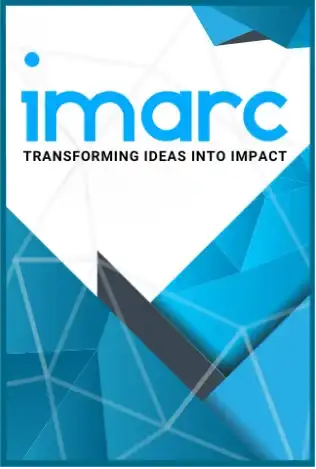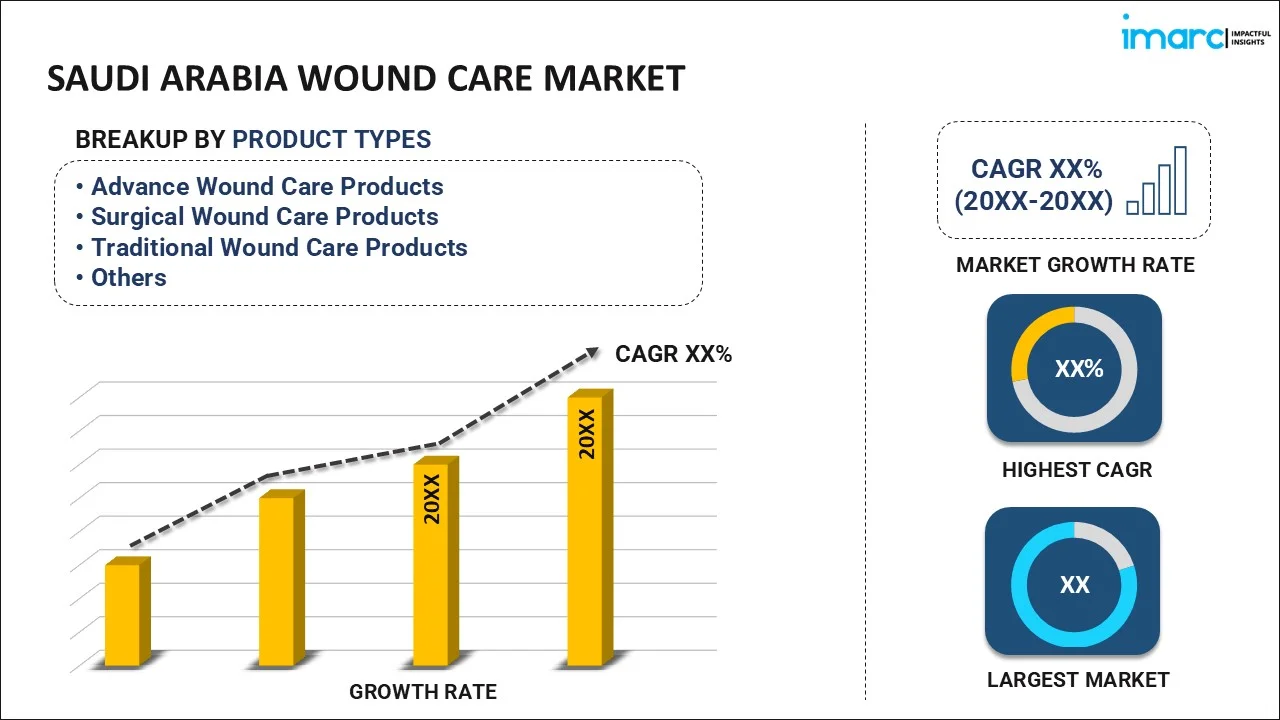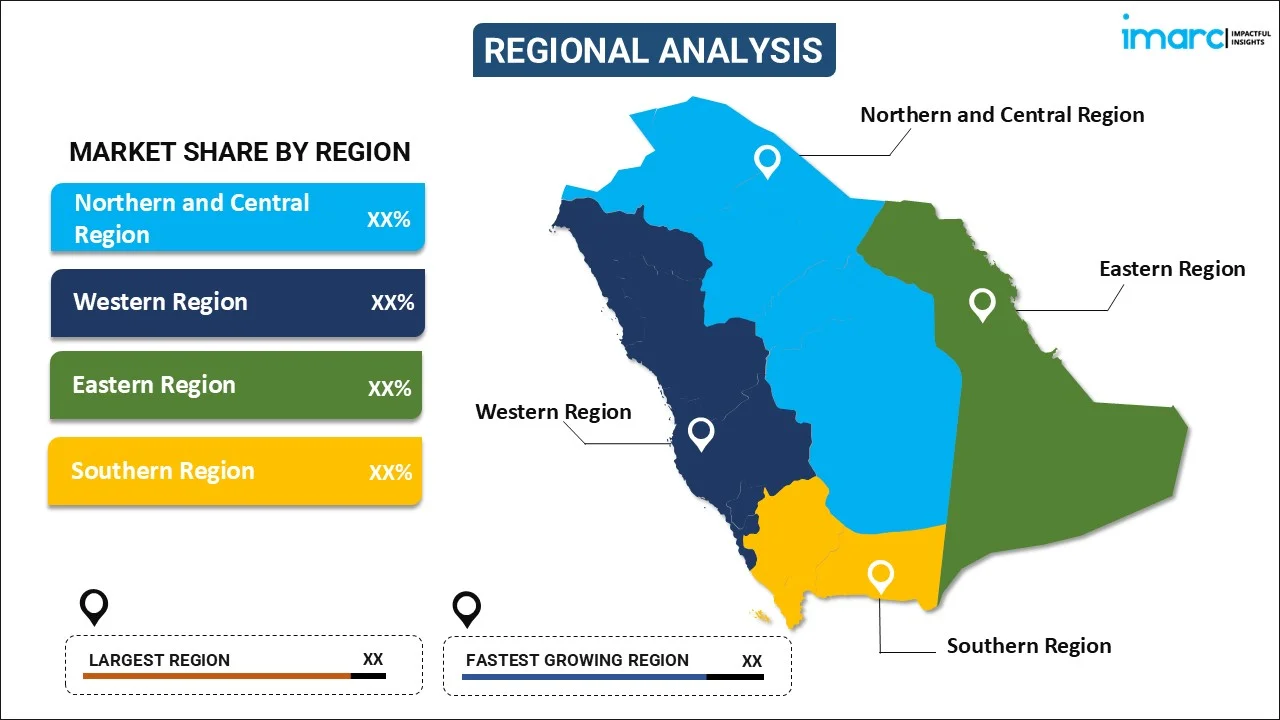
Saudi Arabia Wound Care Market Size, Share, Trends and Forecast by Product Type, Wound Type, End User, and Region, 2025-2033
Saudi Arabia Wound Care Market Overview:
The Saudi Arabia wound care market size reached USD 0.22 Billion in 2024. Looking forward, IMARC Group expects the market to reach USD 0.32 Billion by 2033, exhibiting a growth rate (CAGR) of 4.35% during 2025-2033. The market is growing significantly due to the growing prevalence of chronic wounds, elevating healthcare investments, and innovations in medical technologies. In line with this, the amplifying need for advanced wound care solutions is further bolstered by enhanced healthcare infrastructure and a rising emphasis on patient outcomes.
|
Report Attribute
|
Key Statistics
|
|---|---|
|
Base Year
|
2024
|
|
Forecast Years
|
2025-2033
|
|
Historical Years
|
2019-2024
|
| Market Size in 2024 | USD 0.22 Billion |
| Market Forecast in 2033 | USD 0.32 Billion |
| Market Growth Rate (2025-2033) | 4.35% |
Saudi Arabia Wound Care Market Trends:
Amplifying Demand for Advanced Wound Care Solutions
The Saudi Arabia wound care market growth is witnessing an elevation in the requirement for cutting-edge wound care products, mainly boosted by the magnifying incidents of chronic conditions such as obesity and diabetes, which increase the risk of chronic wounds. For instance, according to a research article published in the journal Healthcare in January 2023, diabetes mellitus affects 17.7% of Saudi Arabia’s adult population, marking the country as having the second-highest prevalence in the region and ranking seventh globally. Resultantly, such advanced solutions, including foam dressings, hydrocolloid dressings, and hydrogels, are increasingly being preferred as they provide improved infection control and healing advantages over conventional dressings. In addition to this, healthcare providers are rapidly prioritizing these products for their high efficacy in managing severe wounds and significantly enhancing patient outcomes. Moreover, the government’s rising focus on proliferating healthcare infrastructure and improving the quality of patient care has further bolstered the popularity of specialized wound care solutions, establishing the country as an evolving market for advanced wound management products.
Heightened Emphasis on Home-Based Wound Care
A significant inclination toward home-based wound care solutions, principally fueled by the accelerating elderly population and an increasing preference for convenient healthcare solutions is boosting the Saudi Arabia wound care market share. For instance, a research article published in the journal BMC Health Services Research in December 2023 states that in Saudi Arabia, the ratio of individuals aged over 65 to those aged 20–64 is projected to nearly double between 2020 and 2030. Home care products, such as self-application devices, antiseptics, or wound dressings, enable patients to handle their wounds with minimal or no requirement for clinical intervention, notably lowering the need for hospital resources. Moreover, this trend aligns with the Saudi government's Vision 2030 objectives to improve healthcare access, support patient-centric care, and promote public health through prevention and health awareness in society. In addition to this, the significant proliferation of home healthcare services as well as telemedicine further fosters this trend, allowing efficient wound management from home and substantially magnifying the demand for user-friendly wound care products suited for self-application.
Technological Innovations in Wound Care Products
Ongoing technological advancements are notably revolutionizing the Saudi Arabia wound care market outlook, with advanced products, such as negative pressure wound therapy systems, antimicrobial dressings, and skin substitutes, rapidly gaining momentum. Such technologies significantly enhance healing rates, improve comfort, and lower infection risks, positioning them as a preferable option in healthcare facilities. Moreover, both Saudi clinics and hospitals are rapidly opting for such solutions to cater to the demands of patients with chronic or complicated wounds. In addition to this, with amplifying aid from government healthcare initiatives, such advancements are bolstering greater adoption of advanced wound care products, attracting heavy investments from international players, and propelling the market toward modernized, technology-based solutions that align with international standards. For instance, in May 2024, TVM Capital Healthcare closed its Saudi-focused TVM Healthcare Afiyah Fund, raising approximately USD 250 million to support healthcare advancements aligned with Saudi Vision 2030. Among initial investments, DEBx Medical, a Dutch company specializing in innovative chronic wound care products, announced plans to enter the Saudi market, bringing advanced solutions to enhance local healthcare infrastructure and patient care.
Saudi Arabia Wound Care Market Segmentation:
IMARC Group provides an analysis of the key trends in each segment of the market, along with forecasts at the region level for 2025-2033. Our report has categorized the market based on product type, wound type, and end user.
Product Type Insights:

- Advance Wound Care Products
- Foam Dressing
- Hydrocolloid Dressing
- Film Dressing
- Alginate Dressing
- Hydrogel Dressing
- Collagen Dressing
- Others
- Surgical Wound Care Products
- Sutures
- Staplers
- Tissue Adhesive, Sealants & Hemostats
- Anti-effective Dressing
- Traditional Wound Care Products
- Medical Tapes
- Cleansing Agent
- Active Wound Care Products
- Biological Skin Substitutes
- Topical Agents
- Wound Therapy Devices Products
- Negative Pressure Wound Therapy
- Oxygen and Hyperbaric Oxygen Equipment
- Electric Stimulation Devices
- Pressure Relief Devices
- Wound Assessment & Monitoring Devices
- Others
The report has provided a detailed breakup and analysis of the market based on the product type. This includes advanced wound care products (foam dressing, hydrocolloid dressing, film dressing, alginate dressing, hydrogel dressing, collagen dressing, others), surgical wound care products (sutures, staplers, tissue adhesive, sealants & hemostats, anti-infective dressing), traditional wound care products (medical tapes, cleansing agent), active wound care products (biological skin substitutes, topical agents), and wound therapy devices products (negative pressure wound therapy, oxygen and hyperbaric oxygen equipment, electric stimulation devices, pressure relief devices, wound assessment & monitoring devices, others).
Wound Type Insights:
- Chronic Wounds
- Diabetics Ulcers
- Pressure Ulcers
- Venous Leg Ulcers
- Others
- Acute Wounds
- Surgical Traumatic Wounds
- Burns
A detailed breakup and analysis of the market based on the wound type have also been provided in the report. This includes chronic wounds (diabetic ulcers, pressure ulcers, venous leg ulcers, and others) and acute wounds (surgical traumatic wounds, burns).
End User Insights:
- Hospitals & Clinics
- Long-Term Care Facilities
- Home Care Setting
- Others
The report has provided a detailed breakup and analysis of the market based on the end user. This includes hospitals & clinics, long-term care facilities, home care setting, and others.
Regional Insights:

- Northern and Central Region
- Western Region
- Eastern Region
- Southern Region
The report has also provided a comprehensive analysis of all the major regional markets, which include the Northern and Central Region, Western Region, Eastern Region, and Southern Region.
Competitive Landscape:
The market research report has also provided a comprehensive analysis of the competitive landscape. Competitive analysis such as market structure, key player positioning, top winning strategies, competitive dashboard, and company evaluation quadrant has been covered in the report. Also, detailed profiles of all major companies have been provided.
Saudi Arabia Wound Care Market News:
- In September 2024, Oxybarica, a leader in hyperbaric oxygen therapy (HBOT), announced plans to expand its foothold in the Middle East, including Saudi Arabia, to meet the growing demand for advanced wound care and therapeutic solutions. This strategic move aims to enhance healthcare standards through HBOT and foster collaboration with regional providers to improve patient outcomes and care quality.
- In August 2024, STADA, a leading pharmaceutical company, announced the strategic acquisition of FITO™ from LEO Pharma to further expand its consumer healthcare business in the Middle East region. This medical device, utilizing the wheat extract Rigenase, is indicated for dermatological applications, including the treatment of wounds, first- and second-degree burns, ulcers, and abrasions. The acquisition includes the integration of existing business operations across key markets, including Saudi Arabia.
Saudi Arabia Wound Care Market Report Coverage:
| Report Features | Details |
|---|---|
| Base Year of the Analysis | 2024 |
| Historical Period | 2019-2024 |
| Forecast Period | 2025-2033 |
| Units | Billion USD |
| Scope of the Report | Exploration of Historical Trends and Market Outlook, Industry Catalysts and Challenges, Segment-Wise Historical and Future Market Assessment:
|
| Product Types Covered |
|
| Wound Types Covered |
|
| End Users Covered | Hospitals & Clinics, Long-Term Care Facilities, Home Care Setting, Others |
| Regions Covered | Northern and Central Region, Western Region, Eastern Region, Southern Region |
| Customization Scope | 10% Free Customization |
| Post-Sale Analyst Support | 10-12 Weeks |
| Delivery Format | PDF and Excel through Email (We can also provide the editable version of the report in PPT/Word format on special request) |
Key Questions Answered in This Report:
- How has the Saudi Arabia wound care market performed so far and how will it perform in the coming years?
- What is the breakup of the Saudi Arabia wound care market on the basis of product type?
- What is the breakup of the Saudi Arabia wound care market on the basis of wound type?
- What is the breakup of the Saudi Arabia wound care market on the basis of end user?
- What is the breakup of the Saudi Arabia wound care market on the basis of region?
- What are the various stages in the value chain of the Saudi Arabia wound care market?
- What are the key driving factors and challenges in the Saudi Arabia wound care?
- What is the structure of the Saudi Arabia wound care market and who are the key players?
- What is the degree of competition in the Saudi Arabia wound care market?
Key Benefits for Stakeholders:
- IMARC’s industry report offers a comprehensive quantitative analysis of various market segments, historical and current market trends, market forecasts, and dynamics of the Saudi Arabia wound care market from 2019-2033.
- The research report provides the latest information on the market drivers, challenges, and opportunities in the Saudi Arabia wound care market.
- Porter's five forces analysis assist stakeholders in assessing the impact of new entrants, competitive rivalry, supplier power, buyer power, and the threat of substitution. It helps stakeholders to analyze the level of competition within the Saudi Arabia wound care industry and its attractiveness.
- Competitive landscape allows stakeholders to understand their competitive environment and provides an insight into the current positions of key players in the market.
Need more help?
- Speak to our experienced analysts for insights on the current market scenarios.
- Include additional segments and countries to customize the report as per your requirement.
- Gain an unparalleled competitive advantage in your domain by understanding how to utilize the report and positively impacting your operations and revenue.
- For further assistance, please connect with our analysts.
 Inquire Before Buying
Inquire Before Buying
 Speak to an Analyst
Speak to an Analyst
 Request Brochure
Request Brochure
 Request Customization
Request Customization




.webp)




.webp)












